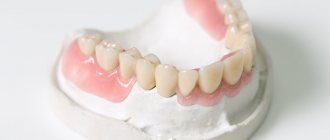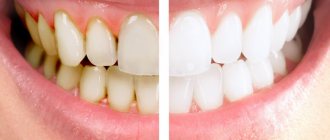A clasp denture is an ideal solution for restoring a number of teeth in the lower jaw, when the patient has retained several of his dental units, but it is not possible to install a full-fledged bridge on them for objective reasons. Also, this design is ideal if the patient does not want (or cannot) install implants, but wants to restore his smile and achieve optimal results for a reasonable budget. Yes, the clasp prosthesis for the lower jaw is a removable model, but it copes with the task perfectly, is a worthy alternative to outdated plate models, and the service life of such a solution is from 10 years.
Removable clasp prosthesis for the lower jaw - consider in detail
Why is a denture for teeth called clasp? The name itself comes from the word “arc”. It is based on a thin cast arc-shaped metal element, onto which a plastic base imitating gum is fixed, as well as artificial crowns - smooth and beautiful teeth. Thanks to the arch, the teeth replacement system is highly durable and reliable, because it will have to be removed and put on at least once a day. As a result, the patient receives a compact, lightweight, comfortable prosthesis for the lower jaw, which is easy to get used to in the first few hours after installation.
How is the prosthesis fixed on the supporting, pre-prepared teeth of the lower jaw? Using hooks or special elements. They are placed on top of the patient’s teeth or on pre-implanted implants. By the way, the prosthesis locks themselves are made not only of a metal alloy, but also of plastic, which is especially important for people with an allergic reaction to metal. But the gums can be made of either nylon or plastic bases (acri-free, quadrotti solutions). When it comes to dental crowns, they are usually made from a plastic material that imitates enamel.
It is important! The specificity of the prosthesis for the lower jaw presupposes that the arch is located on the side of the tongue, that is, where it is not visualized at all. The distance from the arch to the cervical area of the teeth is approximately one millimeter, and a little more is the distance to the bottom of the mouth.
Types of dentures on hooks
Hooks help fix different types of prostheses:
- Acrylic dentures. This is the cheapest and most common option. The design consists of an acrylic base with artificial crowns attached to it. Most often, “teeth” are also made of acrylic; crowns made of ceramics are less common. The prosthesis is adjacent to the gum and is additionally secured with hooks. The shade of the base is selected to match the natural color of the patient’s gums. The disadvantage of acrylic is that it does not always look natural due to its opacity. The prosthesis is durable, light and cheap, which is a definite advantage. Disadvantages include poor aesthetics and the need to get used to a rigid and fairly voluminous structure.
- Clasp dentures. More expensive and, undoubtedly, ahead of other prosthetic models in terms of comfort, strength and other indicators. The principle of the structure is the same as that of acrylic ones, but instead of a massive acrylic base, clasp structures have a thin metal plate (on the sides the dentures also have plastic parts in the color of the gums). They are durable and take up much less space in the mouth. The main condition for their installation is the patient’s own teeth on both sides of the jaw. The clasp denture correctly distributes the load when chewing, which allows you to slow down the process of resorption of bone tissue where there are no teeth.
- Nylon prostheses. Partial designs made of nylon with hooks are much less noticeable in the mouth due to the fact that their clasps are made of the same material as the base. Nylon has the desired transparency, making it almost invisible when talking or smiling. Prostheses of this type are comfortable due to their flexibility and softness; they do not rub and do not require a long period of getting used to. There are also disadvantages. The main one is the failure of nylon hooks. They are soft and cannot provide proper load distribution.
Indications for prosthetics
Clasp dentures are installed on the lower jaw if:
- there is an extensive defect - for example, more than two teeth in a row are missing;
- all teeth are completely missing - in this case, to fix the prosthesis, the patient is first implanted with supporting implants;
- the last teeth in the row are missing;
- The patient has chronic periodontitis and there is a need to additionally strengthen the remaining teeth in the row with the help of a prosthesis.
In the meantime, prosthetics with clasp artificial structures are not recommended when:
- there are less than four teeth left in the jaw - unfortunately, this is not enough for a high-quality support base;
- the patient suffers from acute chronic illnesses;
- bone problems have been diagnosed (for example, osteomyelitis of the jaw, as well as osteoporosis);
- a person has an inflamed oral mucosa.
Advantages and disadvantages of clasp fastening
The pros and cons depend on what type of hooks are used.
- Metal hooks. Durable, securely fixed, and have sufficient rigidity to fully distribute the chewing load. Disadvantages: they can damage the surface of supporting teeth and are noticeable to others. Such hooks can rest on teeth covered with metal-ceramic crowns. In this case, reliable fixation will do without thinning the tooth enamel.
- Nylon hooks. Almost invisible, soft, comfortable. Disadvantages are also due to the softness of the material. Clasps of this type cannot distribute the load correctly; over time, the stability of the prosthesis decreases significantly.
The average cost of dentures in Moscow is from 9,000 rubles to 60,000 rubles.
The process of getting used to the clasp prosthesis - features and nuances
The process of getting used to a clasp denture installed on the lower jaw is not at all quick. At first, the patient may be bothered by excessive salivation and discomfort while chewing food. There may also be speech defects - it is difficult for a person to pronounce hissing and whistling sounds. Also, at first you may feel a slight rubbing of the oral mucosa, but this is normal.
If discomfort when wearing dentures bothers you for more than a week, you need to visit a dentist. The system may need to be adjusted slightly to resolve the discomfort.
Service life of dentures with hooks
The lifespan of a clasp denture is about five years. Nylon can be used less as it is more flexible and susceptible to deformation. Replacement is required because the fixation strength decreases over time. This occurs due to the gradual resorption of bone tissue and subsequent disruption of the fit of the structure. Due to the fact that clasp dentures correctly distribute the load, the atrophy process is slower. Nylon, due to its softness, allows the process to go faster.
An alternative to clasp fixation is to attach it to locking attachments. Fastening elements are placed on crowns fixed to abutment teeth. Locks allow you to firmly fix the structure.
Author:
Mayorov Andrey Mikhailovich
Specialization:
orthopedic dentistry, dental prosthetics, implant installation
How much does a clasp prosthesis cost?
The price of lower jaw prosthetics using a clasp design depends on the following factors:
- base and frame material;
- the number of teeth that need to be restored with a prosthesis;
- material for dental crowns.
The average price of a clasp prosthesis is from 32,000 rubles. The price, as a rule, already includes payment for the prosthesis itself, treatment planning, installation of the system, and check-ups with the dentist.
Clasp dentures are an inexpensive and accessible way to restore a smile with a long service life (more than 10 years).
Types of clasps
Depending on the material, clasps for fixing dentures are:
- Metal.
- Plastic or nylon.
- Metal-plastic.
Metal hooks have the lowest aesthetics. They are visible when talking and smiling. Nylon ones are made in the color of the gums, have the required transparency, due to which they are practically invisible to others. Their disadvantage is the incorrect distribution of the load during chewing. The material is soft and cannot provide the required rigidity (unlike less aesthetically pleasing metal).
Depending on the type of fastening, clasps are of dental, gingival and mixed types. According to the manufacturing method - bent, cast and combined.
Fixation of removable dentures on implants
There are three types of fixation of removable dentures on implants: beam, spherical and push-button.
Beam mount
With beam fixation, the implants are connected to each other by a metal beam on which the orthopedic structure is installed: this provides good stability and allows chewing pressure to be evenly distributed. The result is a so-called removable denture on a beam and on implants.
In this case, the beam remains on the implants, so this option should not be confused with fixed prosthetics on implants. In the second case, the beam also serves as a connecting element for implants (splints and stabilizes them), however, it is lined with acrylic gum on top, and set teeth are placed. The prosthesis itself is fixed with screws.
Ball mount
Ball-shaped fastening is considered to be of lower quality, but will be significantly cheaper: the top of the implant has a ball-shaped abutment, which is installed in a recess in the prosthesis and securely fixed.
Push-button fastening
This is a relatively new option that is similar to a spherical system. But the push-button type is a more reliable fastening. Inside the prosthesis is the second part of the lock; when put on, the prosthesis snaps into place.
Removable dentures on implants
Almost all orthopedic structures supported by implants are removable in one way or another, since access to titanium roots is necessary for preventive procedures and hygiene. But this does not mean that such dentures can be easily removed from the mouth: often this can only be done in the dentist’s office. Such structures are called conditionally removable (or better yet, even non-removable, since you do not need to remove such a prosthesis yourself); they are usually used to restore several missing teeth. A conditionally removable denture on implants is fixed using a screw fastening, which, if necessary, your attending physician can temporarily unscrew.
But with complete edentia, removable dentures are also installed on implants, which you can remove yourself, without complex manipulations or the help of a dentist.
Note!
Removable dentures on implants are far from a budget option for dental restoration. At the same time, such prosthetics, compared to fixed ones, has a fairly large number of disadvantages.
Removable denture on mini-implants
If you have restrictions on classical implantation or are very limited in budget at the moment, a removable denture with mini-implants will help restore lost teeth. Mini-implants are miniature titanium roots that are installed in soft tissue. They are unable to bear heavy loads, so fixed bridges cannot be placed on them (under high pressure, mini-implants can simply fall in or damage the structure), however, removable metal-free dentures are excellent for supporting mini-implants.
But here it is important to remember that when installing mini-implants, the chewing load should be minimal. There will be many dietary restrictions: nuts and hard meat are prohibited.
Manufacturing of removable dentures on implants
If you want to have a complete denture supported by implants, you will have to go through several stages of treatment.
Stage 1 - diagnosis.
diagnostics. Before prosthetics, it is necessary to undergo a number of diagnostic procedures and undergo several tests designed to assess the condition of the oral cavity and the entire body in order to identify possible contraindications to the procedure. Everything here is the same as with conventional single implantation: diseases of the immune system, cancer and diabetes are the main contraindications. A computed tomography scan is required and bite parameters are taken.
Stage 2 - bone grafting.
bone grafting. If the patient lacks bone tissue, bone grafting is also performed during implantation. They can also be carried out simultaneously with the implantation.
Note!
Today, there are protocols that allow prosthetics without bone grafting - this is implantation with immediate loading: all-on-4, all-on-6, basal or zygomatic complex implantation. With these approaches, only fixed prostheses are placed, and 1-3 days after surgery for implantation.
Stage 3 - implantation.
The number of titanium roots implanted into the jaw can vary: on average, up to 6 implants are installed on one jaw, however, there are protocols that involve a removable denture on 4 implants and even a removable denture on 2 implants.
“It is important to pay attention to the fact that the more implants there are in the jaw, the better and more reliable the fixation of the prosthesis will be. Often, with such removable prosthetics, in order to reduce the cost, only 2 implants are placed, but this is catastrophically not enough - the system will very quickly fail,” notes Yuri Vasin.
Stage 4 - installation of the prosthesis.
After the implants are installed and the stage of their engraftment is completed (on average, from 3 to 6 months), the doctor takes impressions, after which, after fitting and adjustment, the removable denture is fixed on the implants. Making a removable denture on implants takes about a week.










